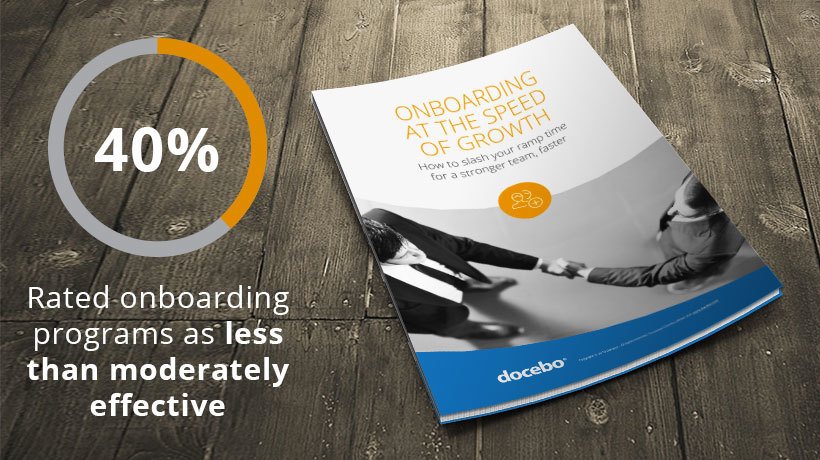Using Your Learning Management System For Onboarding: Why You Need To Link Your LMS To A Stronger Onboarding For Employee Growth
In this article we will discuss why it is so important to use your Learning Management System for onboarding experiences. Whether you’d like to admit it or not, onboarding is a make-it-or-break-it necessity for new hires. This is especially concerning when research shows that one in three companies either do not have an official onboarding process, or their onboarding process does not include structured training.
This lack of training is a significant detriment. Research shows nearly one-third of new hires leave their company, either voluntary or involuntary, before the end of their first year, proving that a successful onboarding program is critical to your employee and company success.
A successful onboarding process utilizes both Talent Management and Learning and Development resources in the Learning Management System (LMS) to engage and retain new hires. Brandon Hall Group found 49% of HR managers are concerned about engaging and retaining employees.
6 Reasons Why Your Onboarding May Be Failing
New hires are leaving companies for a few reasons, a study from the Allied Workforce Mobility Survey found:
- Companies fail to measure employee retention.
- Companies are not allocating funds for onboarding programs.
- Coaching and mentoring are not offered to new hires.
- Training is not included in onboarding.
- Clear expectations are not established at the beginning of employment.
- New hires rarely participate in “stay interviews”.
Tracking these onboarding measures will let you know how successful your onboarding is among your new hires.
Does Your New Hire Measure Up?
There are 4 key metrics that should be tracked in a new recruit’s onboarding:
- Time to productivity or time to proficiency.
- Engagement.
- Cost metrics.
- Employee retention or reduction.
These numbers will tell you whether or not your new hire is progressing at the expected rate. They will also tell you if they’re engaged in their work. Most importantly, all four of these key performance indicators (KPIs) are important to track because, eventually, they will give you a good indication of whether your new hire is polishing up their resume with one foot out the door.
Technology And Onboarding
Technology plays an important role in onboarding. The organizations who onboard successfully use strategies that take advantage of comprehensive Learning Management Systems, before the employee ever interviews. A successful onboarding program includes a combination of techniques:
- Classroom (instructor-led) training.
This type of training is typically time consuming and expensive. Not to mention, studies show that the knowledge retention after an instructor-led training course is awful. Virtual instructor-led training is a way to combat the issues found in classroom instructor-led training because they allow the educators to record a course. This way, learners can attend whenever and wherever they choose. - Online learning.
Classroom instructor-led training is necessary for some training subjects. However, whenever it’s available, online training is better for new hires. This happens because, like virtual instructor-led training, online training can be accessed anywhere, at anytime. eLearning allows content to be delivered in short, on-demand courses from any device. Moreover, it allows educators to reuse content across different courses. This process is made even easier with features like Docebo’s central learning repository. Other benefits of online training are the tracking and reporting features available in a good Learning Management System. - On-the-job training.
On-the-job, or hands on, learning is invaluable to new hires, as it allows them to learn by experience. This type of learning sticks with new hires longer. On-the-job training is a bridge between the knowledge of your educators and your learners; it should be about open transfer of knowledge and feedback.
Onboarding And Its Impact On Bottom Line
A study from the Harvard Business Review found a 23% turnover rate among new hires before their first anniversary due to a poor onboarding experience. This impacts more than your turnover rate. According to the study, “the organizational costs of employee turnover are estimated to range between one and three times the employee’s salary”. Not to mention, it takes many new hires up to eight months to reach full productivity.
Companies with the best onboarding plans do not only focus on the strongest aspects of the program, but they are also devoted to measuring the employee’s impact. By tracking a new hire’s Key Performance Indicators (KPI), these companies are setting the pace for onboarding.
Successful Onboarding
A successful onboarding experience means your new recruit will retain more job related knowledge, and be more passionate and engaged with the workplace. More importantly, the odds of that employee leaving your company within the first year decrease.
On the other hand, a poor onboarding experience typically drives new hires away before they reach their first “workiversary”. This happens due to a lack of that same passion and knowledge that can help build a great working relationship at every stage of employment.
How To Choose The Right Learning Management System For Onboarding
A comprehensive Learning Management System for onboarding is essential. A Learning Management System that offers a centralized location to store your course content enables you to share content across multiple locations easily. Also, an integrated Learning Management System with relatable onboarding content can make it easier for new hires to meet their early-stage goals.
A Learning Management System that links your learners to the experts in your organization is key: Social learning helps employees expand their knowledge base by fostering interactions between colleagues. This type of learning engages the new hires in your company, which is important to maintain. A Learning Management System with gamification features will help instill a sense of accomplishment in your employees, thus motivating them to learn.
A Learning Management System that has a positive user experience bolsters engagement. This means you want to find a Learning Management System that is scalable enough to evolve with your learning needs as your training program evolves over time.
For more information on using your Learning Management System for onboarding, download Onboarding at the Speed of Growth, available from Docebo.









